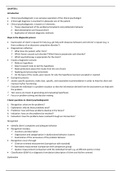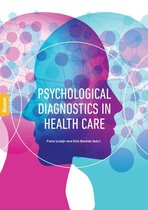CHAPTER 1
Introduction
• Clinical psychodiagnostic is an exclusive specialism of the clinical psychologist
• A thorough diagnosis is essential for adequate care of the patient
• Clinical psychodiagnostic is based on 3 elements:
1. Theory development of the problems/complaints and problematic behavior
2. Operationalization and measurement
3. Application of relevant diagnostic methods
Steps in the diagnostic process
• Examination of client’s request for help (e.g. get help with obsessive behavior) and referrer’s request (e.g. is
there evidence of an obsessive-compulsive disorder?)
• Diagnostician reflection
✓ What does the patient suffer from?
✓ Which factors caused such disorder? Which factors perpetuate such disorder?
✓ Which psychotherapy is appropriate for the client?
• Create a diagnostic scenario
✓ Make an hypothesis
✓ Select research tools to test the hypothesis
✓ Make predictions about the results from this set of tools
✓ Applying and processing instruments
✓ On the basis of the results, give reasons for why the hypothesis has been accepted or rejected
• During this process:
✓ answer specific questions; make clear, specific, and reasonable recommendation in order to help the client and
improve his/her functioning
✓ Evaluate the individual in a problem situation so that the information derived from the assessment can help with
the problem
✓ Test scores are means to generating and evaluating hypotheses
✓ Focus on problem solving and decision making
5 basic questions in clinical psychodiagnostic
1. Recognition: what are the problems?
2. Explanation: why do these problems exist?
3. Prediction: how will these problems develop in the future?
4. Indication: how can the problems be resolved?
5. Evaluation: have the problems been resolved through an intervention?
Recognition
• Identify client’s complaints and adequate behavior
• Recognition includes:
✓ Inventory and description
✓ Organization and categorization in dysfunctional behavior clusters
✓ Examination of the seriousness of the problem behavior
• Recognition occurs through:
✓ Criterion-oriented measurement (comparison with standard)
✓ Normative measurement (comparison with comparison group)
✓ Ipsative measurement (comparison with the individual himself, e.g. at different points in time)
• Classification (DSM V) or diagnostic formulation (description of client and his/her context)
Explanation
,• Includes: the problem or problem behavior, the conditions that explain the problem’s occurrence and the causal
relationship between the problem and its cause
• Explanations may be classified according to:
✓ The locus: e.g. explanatory factors lie in the person or the situation
✓ The nature of control: e.g. problematic behavior is determined by a cause (by previous conditions) or by a
reason (voluntary, intentional choice)
✓ Synchronous (at the same time) and diachronous (at different times) explanatory conditions: e.g. borderline
personality organization is synchronous, whereas oral fixation is diachronous
✓ Induced conditions (that give rise to a behavioral problem) and persistent conditions (perpetuate the
behavioral problem)
Prediction
• Making a statement about the problem behavior in the future
• Based on empirical research
Indication
• Understand whether the client needs treatment and if so which caregiver/assistance/treatment are most
indicated
• There has to be knowledge of treatments and therapies, the usefulness of treatments, the client’s acceptance of
treatment
Evaluation
• Check whether the proposed therapy led to changes in the client’s problem behavior
The diagnostic cycle
• Based on: observation, hypothesis formulation, prediction formulation, testing, results evaluation
• Intake: first information, interview, referrer’s and client’s requests
• Complaint analysis: gather and analyze complaints of client and formulate client’s request for help
• Problem analysis: gather and analyze client’s problem, cluster them and create a provisional classification
• Explanation analysis: analyze causes and factors that contribute to client’s problem, formulate a testable
hypothesis, choose appropriate diagnostic tools, conduct examination and accept/reject the hypothesis
• Indication analysis: formulate hypothesis of treatment
• Advice: provide client with an advice (summarize all previous steps and discuss with the client)
The diagnostic process
,The diagnostic process: application
• Analysis of the referrer’s request: gives an insight into the referrer’s vision of the client and provides information
about the setting of the referrer (e.g. gp or mental health center) and therefore about the seriousness of the
problem, the functioning of the client, etc.
• Analysis of the client’s request for help, including not only what he says, but also the body language, attitude,
etc.
• In order to determine the content of the client’s problem, ask about:
✓ What the main problem is
✓ Complaints, how they arose and developed and the factors that played a role (e.g. mood, physical
complaints, anxiety, social functioning and support, environmental factors, etc.)
✓ Who could best help the patient
✓ What the patient think the result of the intervention should be
The diagnostic process: the diagnostician’s reflection
• Attitude , contact, tuning, unbiased and active listening of the professional in the service of a good relationship
between professional and client
• Professionals and clients each have their own perspective on what constitutes good care
• Risk: thinking to be a guru or a prophet and to have really understood the other
• Diagnosticians should be aware that they may be biased
• Use literature or knowledge
The diagnostic process: diagnostic scenario (complaint and problem analysis)
• Complaint analysis = Formulate the client's complaints and help request
• Problem analysis = Apply knowledge about classification systems and theoretical models. Problems become part
of a theory or classification
• Diagnostic scenario requires the interviewer to organize knowledge about the client and client’s questions (e.g.
chronologically, around domains, etc.)
• Goals:
✓ Informing the client
✓ Applying an empirical framework
✓ Guaranteeing completeness
• Method:
✓ From treatment request to diagnostic (partial) treatment request: check whether the client’s help request
consists of a series of (partial) underlying requests
✓ Analyze sub components of the help request (or underlying requests): interview and assessment
✓ Organize assessment outcomes in a diagnostic scenario
• Analyze underlying requests of the client: e.g.
✓ What is the matter with me?=understanding
✓ Why is this going on with me?=explaining
✓ How can I best be helped?=advising
• Prototype of diagnostic requests:
✓ Help request: Does my child have no friends? Do I have a disorder? = understanding
✓ Help request: Why does my child have no friends? Why can’t I maintain a permanent relationship? =
explaining
✓ Help request: Is my child able to attend the primary school? Can this patient be moved to a lower security
institution = advising
Note: 3 scenarios depending on number of components
o Scenario 1: HELP REQUEST → UNDERSTANDING PROBLEM
o Scenario 2: HELP REQUEST → UNDERSTANDING PROBLEM → EXPLAINING
o Scenario 3: HELP REQUEST → UNDERSTANDING PROBLEM → EXPLAINING → ADVISING
• Formulate an initial, tentative theory about the client’s problem behavior
, • In sum, in diagnostic scenario the professional tries to capture a first picture about the nature of the problems
that builds on complaint analysis, creates a preliminary case inventory of problem areas (feelings , thoughts,
situations in which they occur) and analyzes the beginning, course, and severity of the problems
The diagnostic examination
The diagnostic examination: hypothesis formulation
• Interpreting interview data
✓ Involves clinical judgment and “interpretation”
✓ Evaluate consistency with other sources
✓ Evaluate relevance for purpose of the referral
• Convert tentative hypothesis to a theory that can be tested
• Hypothesis can concern: the presence of psychopathology or differential diagnosis, explanatory factors,
predictors, or treatment
The diagnostic examination: the selection of examination tools
• Select appropriate examination tools
• E.g. questionnaires, checklists, scales, etc.
The diagnostic examination: formulation of testable predictions
• Prepare criteria against which the client will be examined
• E.g. categories as in DSM V or a score or scores for one or more dimensions
The diagnostic examination: administration and scoring
• During administration, observational data are collected
• Test results are then interpreted with the help of norm tables
The diagnostic examination: argumentation
• In argumentation, the administration and scoring results are linked back to the hypothesis and prediction
• Assign a certain weight to the tools
• Reject or do not reject the hypothesis, formulate new hypothesis or integrate other elements into the
hypothesis
The diagnostic examination: report
• The report is for the referrer and contains the results of the diagnostic examination
• Includes test information, facts, interpretation of the facts and conclusion
• Report is usually verbally described to the client, so he can improve it and can be motivated by it
Diagnosis and treatment combinations (DTCs)
• Idea behind DTCs: once a patient has been efficiently diagnosed, the protocol-based treatment that then takes
place is usually evidence-based and clearly fits the diagnosis that has been made
What to do in practice (Problem analysis)






